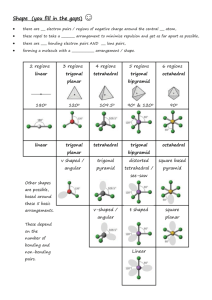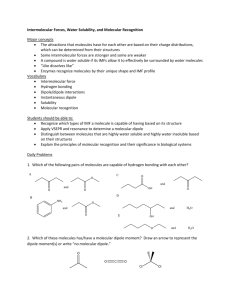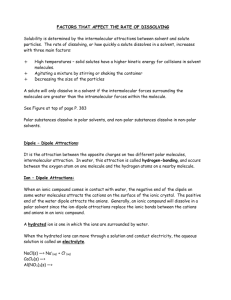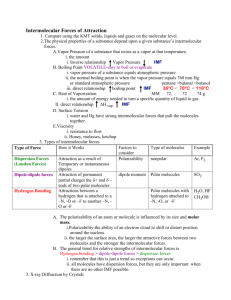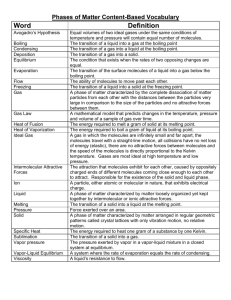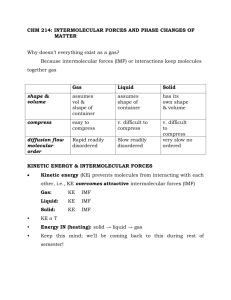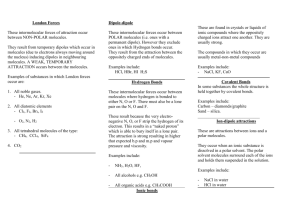ANSWERS: Relate bp to bonding - chemicalminds
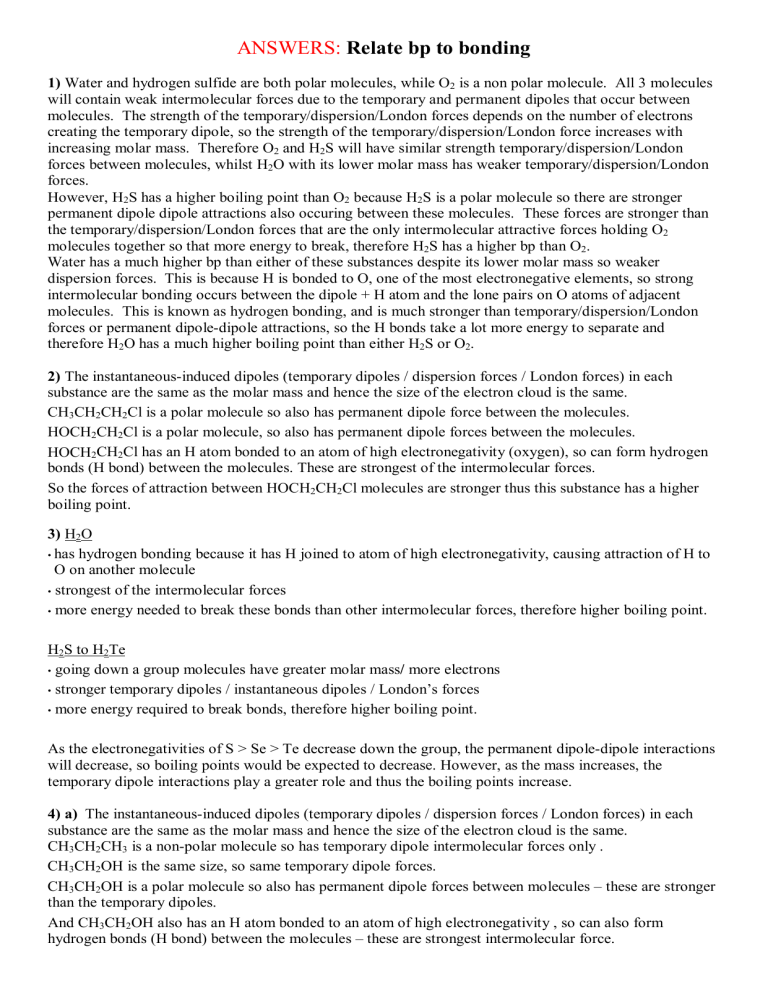
ANSWERS: Relate bp to bonding
1) Water and hydrogen sulfide are both polar molecules, while O
2
is a non polar molecule. All 3 molecules will contain weak intermolecular forces due to the temporary and permanent dipoles that occur between molecules. The strength of the temporary/dispersion/London forces depends on the number of electrons creating the temporary dipole, so the strength of the temporary/dispersion/London force increases with increasing molar mass. Therefore O
2
and H
2
S will have similar strength temporary/dispersion/London forces between molecules, whilst H
2
O with its lower molar mass has weaker temporary/dispersion/London forces.
However, H
2
S has a higher boiling point than O
2
because H
2
S is a polar molecule so there are stronger permanent dipole dipole attractions also occuring between these molecules. These forces are stronger than the temporary/dispersion/London forces that are the only intermolecular attractive forces holding O
2 molecules together so that more energy to break, therefore H
2
S has a higher bp than O
2
.
Water has a much higher bp than either of these substances despite its lower molar mass so weaker dispersion forces. This is because H is bonded to O, one of the most electronegative elements, so strong intermolecular bonding occurs between the dipole + H atom and the lone pairs on O atoms of adjacent molecules. This is known as hydrogen bonding, and is much stronger than temporary/dispersion/London forces or permanent dipole-dipole attractions, so the H bonds take a lot more energy to separate and therefore H
2
O has a much higher boiling point than either H
2
S or O
2
.
2) The instantaneous-induced dipoles (temporary dipoles / dispersion forces / London forces) in each substance are the same as the molar mass and hence the size of the electron cloud is the same.
CH
3
CH
2
CH
2
Cl is a polar molecule so also has permanent dipole force between the molecules.
HOCH
2
CH
2
Cl is a polar molecule, so also has permanent dipole forces between the molecules.
HOCH
2
CH
2
Cl has an H atom bonded to an atom of high electronegativity (oxygen), so can form hydrogen bonds (H bond) between the molecules. These are strongest of the intermolecular forces.
So the forces of attraction between HOCH
2
CH
2
Cl molecules are stronger thus this substance has a higher boiling point.
3) H
2
O
• has hydrogen bonding because it has H joined to atom of high electronegativity, causing attraction of H to
O on another molecule
• strongest of the intermolecular forces
• more energy needed to break these bonds than other intermolecular forces, therefore higher boiling point.
H
2
S to H
2
Te
• going down a group molecules have greater molar mass / more electrons
• stronger temporary dipoles / instantaneous dipoles / London’s forces
• more energy required to break bonds, therefore higher boiling point.
As the electronegativities of S > Se > Te decrease down the group, the permanent dipole-dipole interactions will decrease, so boiling points would be expected to decrease. However, as the mass increases, the temporary dipole interactions play a greater role and thus the boiling points increase.
4) a) The instantaneous-induced dipoles (temporary dipoles / dispersion forces / London forces) in each substance are the same as the molar mass and hence the size of the electron cloud is the same.
CH
3
CH
2
CH
3
is a non-polar molecule so has temporary dipole intermolecular forces only .
CH
3
CH
2
OH is the same size, so same temporary dipole forces.
CH
3
CH
2
OH is a polar molecule so also has permanent dipole forces between molecules – these are stronger than the temporary dipoles.
And CH
3
CH
2
OH also has an H atom bonded to an atom of high electronegativity , so can also form hydrogen bonds (H bond) between the molecules – these are strongest intermolecular force.
So the forces of attraction between CH
3
CH
2
OH molecules are stronger thus this substance has a higher boiling point. b) Both molecules are polar, so same permanent dipole forces.
Able to form same hydrogen bonds to other molecules (because the –O–H group is attracted to the O–H of adjacent molecules) so H bonding force the same.
The difference in the boiling points is related to the shape of the molecule – one molecule having a straight chain, the other, a branched chain.
The straight chain butan-1-ol molecules can pack together more closely / less stearic hindrance / more surface area for formation of temporary dipoles than the 2-methylpropan-2-ol molecules, so even though the molecules have the same molar mass (and so normally same temporary dipole forces) there will be stronger instantaneous / tempoary dipole attraction in the straight chain molecule, thus increasing the boiling point.
5) CH
3
Cl has a greater number of electrons / greater molar mass / greater size, so will have stronger temporary dipole forces than CH
3
NH
2
-imply both have temporary dipoles.
Both molecules are polar, and so will have attractions due to permanent dipoles .
CH
3
NH
2 is able to form hydrogen bonds (H) between molecules and this is the strongest intermolecular force.
Similar
∆ vap
H
°
but H-bonding in CH
3
NH
2
compensates for greater temporary dipoles in CH
3
Cl to give similar overall / net forces of attraction between the molecules so similar
∆ vap
H.
6) i) A has hydrogen bonding AND permanent dipole (PD) / temporary dipole (TD) : attractions
B has PD / TD : attractions
Hydrogen bonding is a stronger attraction ii) C has PD / TD attractions : stronger
D has TD attractions
(attractions = force = bond)
7) HF has hydrogen bonding,
– the strongest intermolecular force,
– so has the highest BP
– F
2
and HCl have (similar) temporary dipole (or similar) forces (as they have same number of electrons)
– However HCl also has, permanent dipole forces (or similar)
–- giving it a higher BP than F
2
.
8) Ethanal, propanal and butanal are all aldehydes. They all have weak intermolecular or permanent dipole forces attracting molecules together.
∆ vap
H
°
increases from ethanal to butanal due to increasing M / electron numbers. The greater the M / electron numbers the greater the strength of intermolecular or temporary dipole forces.
Ethanoic acid has an H atom bonded to an O atom so can form H-bonding between molecules.
H bonding is a stronger intermolecular attraction compared to temporary and permanent dipole forces between the aldehydes.
9) Propanoic acid has lower melting point than butanoic acid because same intermolecular forces (both acids) but Propanoic acid has a smaller mass / less electrons than butanoic acid hence temporary dipoles are weaker.
Ethyl ethanoate has a lower melting point because it cannot form hydrogen bonds between molecules, so intermolecular forces are weaker than for the two acids .
10) a) It is the enthalpy change when one mole of a solid is melted to its liquid state under standard conditions. b) Heptane
Heptane is a small non-polar molecule so the only intermolecular forces are weak. This means heptane will have low values for melting point, boiling point and heats of fusion as all are measures of the strength of intermolecular forces.
Sodium Chloride
Sodium chloride is an ionic solid with strong ionic bonds between all ions in the 3-D network. Water has hydrogen bonds between its molecules and this type of intermolecular attraction is stronger than the instantaneous dipole-dipole attractions that exist between the non-polar heptane or nitrogen molecules. This type of attraction is greater for heptane than nitrogen because of its larger electron cloud/molar mass.
Specific comparisons or justifications that can be made include:
• Boiling point of heptane should be higher than its melting point.
• Melting point for heptane is wrong as it is a liquid at room temperature.
• The high heat of fusion for heptane is inconsistent with its low boiling point.
• The boiling point of heptane should be higher than that for nitrogen.
• The heat of fusion for heptane should be lower than the value for either NaCl or H
2
O.
• The melting point for heptane should be lower than that for water.
• Heptane has a boiling point much lower than water so also should have a heat of fusion that is much lower
– contradictory.
© 2013 http://www.chemicalminds.wikispaces.com
NCEA questions and answers reproduced with permission from NZ
